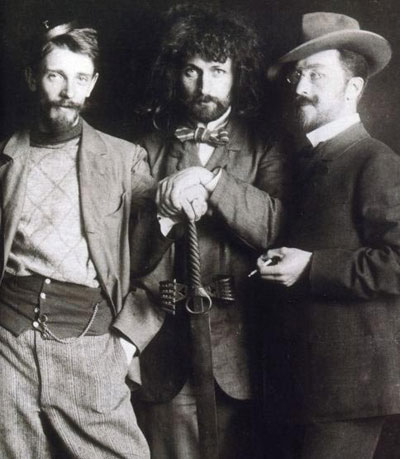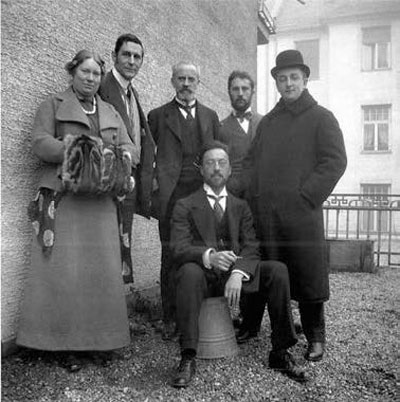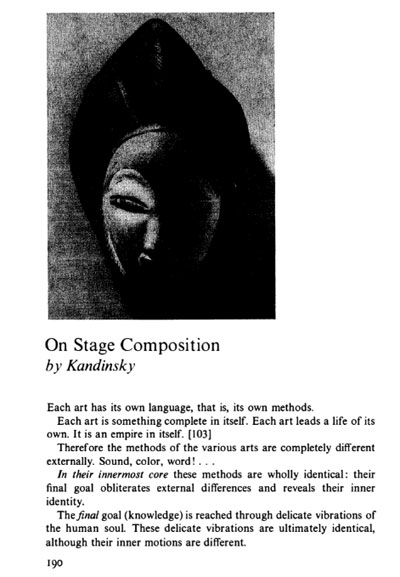|
Kandinsky’s Theatre Life
A Breathless Resume, Part 1
Lissa Tyler Renaud
In general, people who know of Wassily Kandinsky (1866 – 1944) know him from the perspective of his painting life, and many also recognize him as the instigator of abstraction in painting. In fact, he also had a theatre life, and is still today among the most daring of those who have created abstract works for the stage.
In his day, Kandinsky’s plays and his thinking about the theatre were hailed by innovators as theatre-altering as Hugo Ball, founder of Dada, and Oskar Schlemmer, founder of the Bauhaus Theatre. Kandinsky’s “stage compositions” also brought him into contact with other seminal theatrical figures such as Diaghilev, Massine, Stanislavsky, Breton, and many more.
It is exciting to bring “into the fold” Kandinsky’s work and influence beyond painting, and even beyond his commodification by the art world.
What follows is meant to give readers a kind of reference guide, a chronological scaffolding for understanding the mostly extra-painting articles to come in this series: where he was, what he did, who he knew—that kind of thing.
Hoping it contains interesting surprises for those just coming to Kandinsky, as well as for the expert and the devotee.
*
Kandinsky’s life, like his thinking about art, was a process of unifying or merging a range of sprawling, complex elements. He was a Russian who lived primarily in Germany, then spent the last years of his life in Paris. At the opening of his career in Germany and at the close of it in France he was considered a Russian artist, but his Russian compatriots associated him with the romanticism and subjectivity of the German art scene. He held citizenship papers in each of these countries at different times, speaking each of their languages. He traveled in many more countries than he lived in, and studied still more. Ultimately, even when he had a choice, both as an artist and a person he claimed the right to be a true "world citizen."
Along with the sensibilities that he culled from around the world, Kandinsky's work life unified his various areas of training and interest. He was armored as a critic and organizer by professional training in law and economics. He was supported as a teacher of "the science of art" by the methods of systematic inquiry he used doing ethnographic research as a university student. As a painter, he learned anatomical drawing and color theory from one teacher, Anton Ažbè, and the flow of forms from another, Franz [von] Stuck, blending these two influences into an art that extended beyond the realms of both.
At left: Sketches for dresses for the painter Gabriele Münter, early 1900s. At right: Gabriele Münter in dresses designed by Kandinsky. In the Kandinsky in Munich catalogue, 1982, from the Collection Städtische Galerie im Lenbachhaus, Munich.
Kandinsky also looked for ways to unify—to “synthesize”—his other interests. He was an accomplished amateur on the piano and the cello. He wrote poetry. At the turn of the century he sketched period peasant costumes, and designed dresses, embroidered purses and hangings, and jewelry. At various times during his life he also designed wall murals, furniture, vases, and dishes. These interests in the sets, costumes and props of everyday life, as well as in music, poetry and the dramatic impact of a visual image, reveal a temperament that we can see might find satisfaction in the theatre.
In fact, it was to the theatre that Kandinsky turned for a place to synthesize his experiences and abilities. Over a period of 35 years, in Germany, Russia and France, as dramaturg, dramatist and self-appointed demiurge of the art world, Kandinsky pursued his elusive, monumental vision—what he called the Synthesizing, or Unified, Art of the Stage.

Painting students at Anton Ažbè’s school, Munich, 1897. (L to R) A. Seddeler, Dmitry Kardovsky, Wassily Kandinsky.
When Kandinsky came to Munich from Moscow to study painting in 1896 at the age of 30, he had already been struck by the power of the theatre, by a production he had seen of Wagner's Lohengrin. Maybe it was because of this that his activities in Munich brought him into contact with many people who were involved in performance. In 1900, he co-founded Phalanx, an association of young artists who exhibited their works together. One member of this group was Alexander von Salzmann, who later engineered the revolutionary lighting designed by Adolphe Appia for Jacques-Dalcroze's School at Hellerau. Peter Behrens both exhibited with Phalanx and played an influential role in Munich's experimental theatre circles. Behrens worked closely with Georg Fuchs, the great theatre reformer, who was also to become more than tangentially associated with Kandinsky a few years later.
Other members of Kandinsky's society were concurrently involved with a group of avant-garde cabaret performers called Eleven Executioners (Elf Scharfrichter). One was a sculptor named Husgen, who designed masks. Another was Ernst Stern, who designed the group's sets and posters, and who eventually designed for Max Reinhardt's theatre in Berlin. It is interesting to note that two other members of the cabaret group were the playwright Frank Wedekind, who sang, and Reinhard Piper, who was to become Kandinsky's publisher. The Phalanx association continued through 1904.
In 1902, Kandinsky wrote some art correspondence for a journal that was edited by Diaghilev, called The World of Art. In this context, Kandinsky came close to knowing more of Anton Chekhov than just his plays; Chekhov's letters include one to Diaghilev in 1903, in which he refused Diaghilev's invitation to become editor of the journal. Although the art correspondence was his only writing for Diaghilev, Kandinsky followed the publication closely, and surely knew Diaghilev's work in the theatre. Aside from the fact of Diaghilev's prominence in the Russian avant-garde, Kandinsky took an interest in the work of Leon Bakst, who was a painter and also a set and costume designer for Diaghilev. Later events also involved Kandinsky directly with Fokine, Diaghilev's great choreographer.
In 1908, Kandinsky was already thinking about writing for the stage. In 1909 he met Thomas von Hartmann, a young Russian composer who was studying in Munich. Hartmann wrote later that Kandinsky was dissatisfied with the theatre in general, and the opera in particular, from 1909; in any case, they began to experiment together.
Their first idea was to stage one of Andersen's fairy tales. The two of them often developed their ideas with Hartmann improvising at the piano while Kandinsky described what was happening on the stage. Kandinsky sketched a medieval set for the fairy tale, and they created a play text that seems to be the same manuscript called Paradise Garden, which was found in his papers. But that same year, Diaghilev's Ballets Russes created a sensation in Paris, featuring exotic designs by Bakst. After experimenting with translating their fairy tale into a ballet, Kandinsky and Hartmann discarded their idea and started again.
At this time, a Russian dancer named Alexander Sakharoff joined the collaboration. The three of them made it a priority to know something of one another's creative disciplines, and already having some understanding of music in common, Hartmann and Kandinsky set out to learn about dance, starting with ancient Greek dance, while Sakharoff studied the paintings in the museums. In this way, the next project they approached was a staging of Daphnis and Chloe, for which Kandinsky again sketched a set for the opening scene, "a marvelous trireme with warriors, by no means a realistic picture, but it conveyed an astoundingly strong impression of Daphnis' terror."
We hardly ever hear about the association of Kandinsky, Hartmann and Sakharoff without a quotation from Kandinsky’s own description of how they experimented, trying to find the currents that connected their respective arts:
From among several of my watercolors the musician would choose one that appeared to him to have the clearest musical form. In the absence of the dancer, he would play this watercolor. Then the dancer would appear, and having been played this musical composition, he would dance it and then find the watercolor he had danced.
Kandinsky thought that whatever the three of them found by studying together would not only prove the inter-relatedness of their arts, but would also teach him something about painting. Twenty years later he wrote: "It is more profitable for an artist to acquire specialist knowledge of some unfamiliar subject, provided he is able to develop the... capacity for analytical-synthetic thought, than to be narrowly ‘educated’ in his own subject.”
Kandinsky wrote four plays in the years 1908-9. These were Stage Composition I, Voices, which came to be retitled Green Sound; Giants, which was revised and retitled Yellow Sound in March of 1909; Stage Composition III, Black and White; and Stage Composition IV, Black Figure.
Georg Fuchs opened the Munich Artists' Theater in early 1908, and that might have given some impetus to Kandinsky's stage projects. There is no doubt that Kandinsky knew Fuchs' writings on innovative theatre, which were related to the groundbreaking ideas of Adolphe Appia (Swiss) and Edward Gordon Craig (English). Fuchs' work was the talk of Munich art circles, and two of Fuchs' articles even appeared in the same journal, Apollon, that Kandinsky contributed art reviews to in 1909-10. Kandinsky's own writings on the theatre resemble some of Fuchs', but we will never know whether Fuchs actually influenced Kandinsky, or just corroborated what he already felt to be true. Having collected his own ideas for as many as twelve years, Kandinsky finished writing his first book, On the Spiritual in Art in 1910. It was published the
following year. This early book already contained a discussion of "new dance," with reference to Isadora Duncan; it also introduced the principles of "the theater of the future" that Kandinsky would invoke for the rest of his life.

Friends of The Blue Rider on the balcony of Münter and Kandinsky’s apartment at Ainmillerstrasse, 36, Munich, 1911. L to R: Maria and Franz Marc, Bernhard Koehler, Wassily Kandinsky (seated), Heinrich Campendonk and Thomas Hartmann.
Of all of the plays Kandinsky had written, he singled out Yellow Sound to work on over the longest period of time. He finished it in 1912, and published it the same year in the Blue Rider Almanac, an inter-disciplinary collection of pieces he edited with his great friend, the painter Franz Marc. Before the text of Yellow Sound, Kandinsky included a full essay, "On Stage Composition." In it, Kandinsky talks about his theories of dramatic art at some length, particularly making clear the distance between his own conception of the “synthesizing” stage art and Wagner's gesamtkunstwerk, or “total” work of art—a difference that remained key to Kandinsky’s theatrical ideas.

In 1913 Kandinsky planned to illustrate the Bible with, among others, Franz Marc, Paul Klee and the Expressionist painter and playwright, Oskar Kokoschka. In the first year of his correspondence with Schoenberg (1911), Kandinsky had already asked for news of Kokoschka several times, and had mentioned seeing his paintings three years earlier, that is, when Kokoschka first began to exhibit. 1913 was also the year that Kandinsky's autobiographical Reminiscences appeared; it included a description of his pivotal encounter with Wagnerian theatre. Sounds, an awe-inspiring volume of thirty-eight prose poems was also published, and remains to this day an incomprehensibly hidden treasure of modern literature.
The famed Dadaist Hugo Ball and Kandinsky had met in 1912 when Ball came to the Munich Artists' Theater as dramaturg after studying and teaching in Max Reinhardt's drama school. In early 1914, Kandinsky introduced Ball to Hartmann, who had just taken Kandinsky's script and set designs for Yellow Sound, along with his own music, to Stanislavsky at the Moscow Art Theatre in Moscow. Stanislavsky—whose tastes in theatre experimentation ran in a different vein, and whose theatre had just been producing Turgenev, Molière, and Goldoni—had not shown any interest in it. Ball proposed Kandinsky's Yellow Sound for production at the Munich Artists' Theater. It was planned to be performed with Hartmann's music and Alexander Sakharoff dancing the leading role. During this year, Kandinsky wrote his next known stage composition, Violet Curtain, generally known as Violet. Perhaps the energy for this new play came
from his peers’ recent encouragement for Yellow Sound.

Wassily Kandinsky for his stage composition Violet, Picture 2, 1914. Pencil, watercolor, ink on paper. Detail. Centre Georges Pompidou, Paris.
Also in 1914, Ball made plans with Kandinsky, Marc, Hartmann and Fokine for a book to be titled The New Theater. This was to be a sort of Blue Rider Almanac of experimental theatre. Kandinsky was to write an article on his version of the "total work of art," to be included with articles and stage designs by the others. Klee and Kokoschka were to contribute designs and plays respectively. They hoped for this association of artists to expand into an International Society for Art, a society for modern artists of the theatre, painting, music and dance. In a letter to Schoenberg at this time, in anticipation of a visit from him, Kandinsky wrote: "Here there are all sorts of theater plans, which you have already heard about from Marc. You are therefore awaited with particular eagerness." The "eagerness" of this letter makes it all the
more heartbreaking that every one of these plans for play production, book, international society—and even Schoenberg’s visit—were aborted by the sudden outbreak of World War I.
In an odd twist of fate, the resident Kandinsky and the touring Stanislavsky, both in Germany when war was declared and, as Russians, both suddenly now enemy aliens, found themselves being deported together. Stanislavsky and his entire theatre company had been held at gunpoint, and Kandinsky given 48 hours to leave. Care of a clever ruse devised by a Russian Orthodox priest Kandinsky knew, Kandinsky and Stanislavsky were able to escape being put on a German boat, which could have been dangerous, and instead left for Switzerland together on the same neutral Swiss boat!
*
Part 2 to follow:
Kandinsky’s Theatre Life, 1914 to his death in 1944, and beyond…
Cover Image behind type:
“A Fluttering Figure” 1942, oil on wood
26 X 20 cm. PompidouCenter
Note: An earlier, different version of this article was developed for Dramaturgias journal, Brazil.
|